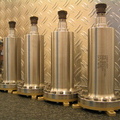Proba-2 is flight-testing a total of 17 technology demonstrators for future ESA missions.
It also serves as a scientific platform for solar and space weather observations.
Credits: ESA/Pierre Carril
Sometimes all it takes is fresh air to get a new lease of life. ESA’s Proba-2 microsatellite is a good example: an influx of nitrogen has replenished its fuel tank, in the process demonstrating a whole new space technology.
On 16 August a telecommand was sent from ESA’s Redu ground station in Belgium to boost the gases in Proba-2’s unusual ‘resistojet’ engine.
Used to maintain the microsatellite’s orbit at 600 km altitude, this experimental engine runs on xenon gas heated before ejection to provide added thrust.
The command added nitrogen gas to the fuel tank, bringing its pressure close to its launch level.
cool-gas generators |
“Nitrogen, like xenon, is an inert, non-reactive gas, so the resistojet can work just as well with a xenon–nitrogen mixture.”
The bottle-shaped cool-gas generators are filled with a rigid solid material that, once triggered, produces more than 250 times its own volume in pure nitrogen gas.
Integrating TNO's four cool-gas generators aboard Proba-2
Credits: TNO
To read more on this subject visit the ESA Proba-2 portal
Credits: TNO
To read more on this subject visit the ESA Proba-2 portal









No comments:
Post a Comment